When it comes to correcting one’s teeth and achieving that picture-perfect smile, the two most common choices are braces and clear aligners (often generically called Invisalign). Not just children but people of all age groups have that desire for straighter teeth that add to their self-esteem and confidence. This desire often leads people to contemplate between the choice of Invisalign or braces.
Although producing great smiles is a shared goal of both Invisalign and braces, they differ in terms of their appearance, treatment duration, comfort, maintenance, and cost. Our aim with this blog is to help you understand the difference between the two orthodontic treatments- invisalign and braces, and help you make an informed decision when it comes time to pursue orthodontic treatment.
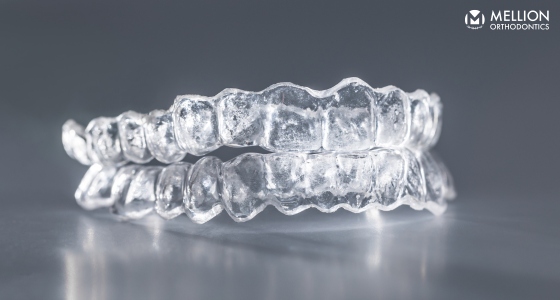
How Does Invisalign Work?
Benefits of Invisalign
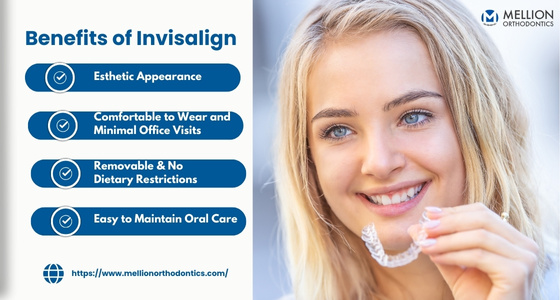
Now that we have gone over the process of how Invisalign works let’s go over the key reasons why people are in favor of it. The benefits of Invisalign treatment are:
Esthetic Appearance
The main reason people desire Invisalign (especially teens and adults) to correct the positioning of their teeth is that Invisalign is made of clear plastic. There are no wires or brackets such as in braces treatments, which makes it look nearly invisible. Because of its discreetness and esthetic look, people frequently request Invisalign by name.
Comfortable to Wear and Minimal Office Visits
The Invisalign clear aligners are fabricated to minimize both their noticeability to the public and discomfort to the patient. Our patients are instructed that their first and last visits with Invisalign treatments will be the longest. At the first visit we place “attachments” on specific teeth, show our patients how to properly insert and remove the trays, and review the essential maintenance processes required throughout treatment. The last visit focuses on the removal of any “attachments” as well as giving our patients a thorough cleaning before discussing retainers. All of the visits between are quick and simple–we check for proper tooth movement and give the patient more trays to continue their treatment. Each tray moves the teeth a small amount, so they are comfortable to wear and don’t create much soreness for the patient.
Removable & No Dietary Restrictions
Another significant reason people prefer Invisalign over braces is because the clear aligners are removable. The patient can choose to remove the Invisalign according to their convenience. We advise our patients to wear the aligners for 20+ hours a day, but we understand there are situations where the patient may want to remove them (going to dinner, on a date, etc.). The trays are always removed while eating, or drinking anything other than water. This allows our patients to eat what they want without fear of breaking any of the appliances.
Easy to Maintain Oral Care
Again, because of the removable factors and without the burden of wires, brackets, or bands, maintaining good oral hygiene practice is extremely easy. The Invisalign clear aligner can be easily removed, and brushing, flossing, or any other oral care can be done the same way one did before starting their Invisalign treatment.
Drawbacks of Invisalign
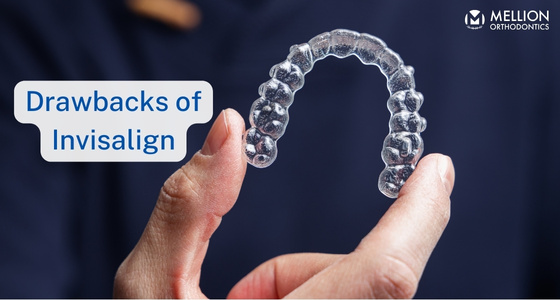
Although Invisalign is a revolutionary way to straighten one’s teeth, it does have some of its shortcomings. The drawbacks of Invisalign are:
Compliance
The flexibility of being able to remove and wear the Invisalign tray is both a positive and a drawback. Successful Invisalign treatment requires discipline and commitment to wear the clear aligners for an average of 20 to 22 hours a day for the duration of treatment. One of the major reasons why Invisalign treatment fails or takes longer to achieve the desired outcome is because of the need for patient compliance when it comes to wearing the aligners as prescribed.
Speech Difficulty
Wearing Invisalign may impact the speech of the patient mainly in the initial days because it’s a new experience and also because of its long wear time. They might experience difficulty pronouncing their ‘s’ sounds and make people speak with a mild lisp. While it might be a prominent issue during the initial days of the treatment, the majority of people don’t experience this issue as well. We instruct our patients to read aloud or spend some time talking at home to get used to the presence of the clear aligners. In certain instances, patients will remove their trays for important work meetings or social events with the understanding that the trays will be in their mouths for all other times.
What are Braces?

How Do Braces Work?
Benefits of Braces
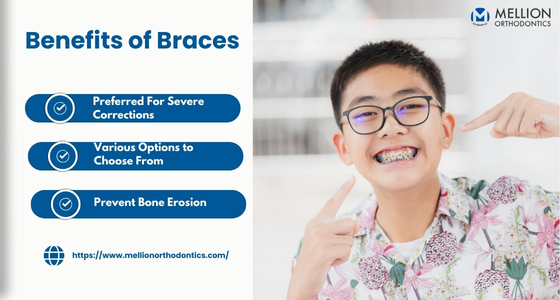
Traditional braces are often the first method people think of when pursuing orthodontic treatment. Braces offer tremendous benefits, largely because of its long history and effectiveness. So, let’s look at the benefits of braces to make an informed decision:
Preferred For Severe Corrections
Braces, historically, have been the most preferred treatment for both minor and severe orthodontic corrections. From minor gaps in the tooth to complex cases such as temporomandibular joint issues, braces are ideal for correcting the alignment of the jaws and teeth, resulting in a perfect smile.
Various Options to Choose From
Braces come in a variety of options- traditional metal braces, ceramic braces, and lingual braces. Depending on the severity of the dental condition and the lifestyle choices of the patient, they can choose to go with the traditional metal braces or a more esthetic option such as ceramic braces.
Prevent Bone Erosion
When the teeth aren’t aligned correctly and have excessive gaps between them, they can deteriorate the bones around them. The oral bacteria make their way to the gums, damaging them and slowly damaging the bones as well. Braces prevent bone erosion as they move the teeth to their correct positions.
Drawbacks of Braces
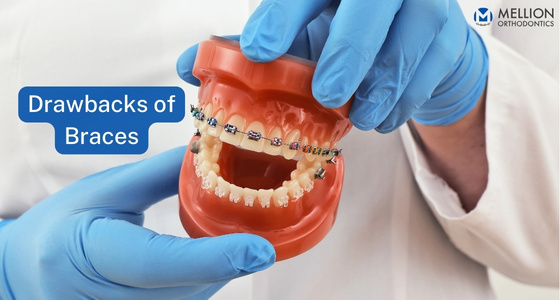
Braces are a fantastic option for orthodontic treatment, but there are also some drawbacks you should be aware of to make an informed decision. The drawbacks of braces are:
Pain and Discomfort
Placing the braces at the start of treatment requires an extensive visit. The process begins with the placement of the brackets, followed by the wires, and ends with an overview of keeping everything clean. We explain to our patients that, while the time in our office isn’t painful, as the wires start to move the teeth (usually within 3-4 hours) some of the patient’s teeth will become quite sore. We recommend a soft diet through the remainder of the day, and often into the next day as well. The braces also contain wires which can irritate the patient’s cheeks, lips, and gums. While this improves over time, the initial few weeks can be quite uncomfortable until the mouth adapts to the presence of braces.
Esthetic Concerns
Another important reason why teens and adults often prefer something other than traditional braces is because they’re very noticeable. When one speaks or smiles, the braces are visible, and that sometimes makes the patient self-conscious.
Diet Restrictions Difference Between Invisalign and Braces
As mentioned before, braces have brackets, bands, and wires. And they aren’t removable like Invisalign clear aligners. These are all breakable, especially if the patient eats hard and sticky foods. Eating hard food can damage or shift the positioning of the braces, while sticky foods can get stuck around the braces. Proper oral hygiene is imperative to keep the braces in good working order and to prevent cavities and decalcification (white spots) on the teeth.
Invisalign vs. Braces: Brief Comparison
| Checklist | Invisalign | Braces |
|---|---|---|
| Treatment Duration | 6 to 24 months | 6 months to 3 years |
| Cost | $3,000–$8,000 | $2,000–$6,000 |
| Removable | Removable | Non-removable |
| Dietary Restrictions | No | Yes |
| Dental Severity | Minor and moderate cases | Minor, moderate, and severe cases |
| Wear Time | 20 to 22 hours a day | Throughout the treatment period |
| Discreet and Aesthetic | Yes | Traditional metal braces, no Ceramic braces–partially Lingual Braces, yes but painful |
Braces or Invisalign: What Should You Choose?
All in all, in the debate of braces vs Invisalign, both are effective when it comes to straightening the teeth. And they both have their pros and cons. The choice between the two truly depends on the personal choice of the patient and the severity of their initial tooth misalignment.
Braces are noticeable but effective for complex issues. They require daily maintenance and come with significant dietary restrictions. Invisalign is discreet, suitable for milder and moderate cases, removable for easier oral hygiene, and offers more dietary freedom. It would be best if you considered factors like the severity of your dental problems, appearance concerns, lifestyle, comfort, maintenance, and cost. It’s crucial to be well-informed about the two orthodontics treatments and consult with the orthodontist to know the best treatment plan for you.
FAQs
Can You Do Braces and Invisalign Treatment at the Same Time?
The simple answer is no. Braces and Invisalign approach tooth movement differently, so the best efficiency is to stick with only one option. However, there are instances where we will offer to start a patient with braces for a short time and then transition to Invisalign to complete the treatment. This often adds time to the treatment, as well as an increased cost.

